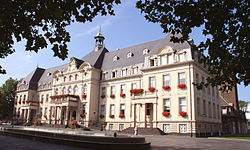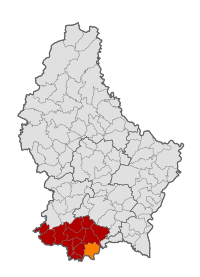
Back Diddeleng ALS دوديلانج Arabic Дзюдзеланж Byelorussian Дзюдэлянж BE-X-OLD Dudelange Catalan Dudelange (munisipyo) CEB Dudelange Czech Dudelange Danish Düdelingen German Dudelange DIQ
Dudelange
| |
|---|---|
 The town hall | |
 Map of Luxembourg with Dudelange highlighted in orange, and the canton in dark red | |
| Coordinates: 49°29′00″N 6°05′00″E / 49.4833°N 6.0833°E | |
| Country | |
| Canton | Esch-sur-Alzette |
| Government | |
| • Mayor | Dan Biancalana (LSAP) |
| Area | |
| • Total | 21.38 km2 (8.25 sq mi) |
| • Rank | 51st of 100 |
| Highest elevation | 435 m (1,427 ft) |
| • Rank | 26th of 100 |
| Lowest elevation | 256 m (840 ft) |
| • Rank | 60th of 100 |
| Population (2023) | |
| • Total | 21,953 |
| • Rank | 4th of 100 |
| • Density | 1,000/km2 (2,700/sq mi) |
| • Rank | 7th of 100 |
| Time zone | UTC+1 (CET) |
| • Summer (DST) | UTC+2 (CEST) |
| LAU 2 | LU0000203 |
| Website | dudelange.lu |
 | |
| Click on the map for a fullscreen view | |
Dudelange (French: [dyd(ə)lɑ̃ʒ]; Luxembourgish: Diddeleng [ˈdidəleŋ] ; German: Düdelingen [ˈdyːdəlɪŋən]) is a commune with town status in southern Luxembourg. It is the fourth-most populous commune, with 22,043 inhabitants. Dudelange is situated close to the border with France.
The commune also includes the smaller town of Budersberg, to the north-west. The Mont Saint-Jean, close to Budersberg, hosts the ruins of a medieval castle. In 1794 the French Revolutionary Army committed atrocities against the local population in Dudelange, when they massacred 79 civilians.[1]
Dudelange is an important industrial town that grew out of the three villages and a steel mill in 1900. The D in the name of the ARBED steel company, later merged into ArcelorMittal, stood for Dudelange. As well as the Dudelange Radio Tower, an FM radio and television transmitter, it is also the site of the Centre national de l’audiovisuel (CNA), a cultural institute founded in 1989 under the aegis of the Ministry of Culture in order to preserve, promote and exhibit Luxembourg's audiovisual and photographic heritage. The centre hosts a two-screen cinema, a restaurant and a library focused on the visual arts
On the 14 February 2017 the Dudelange train collision happened here.
- ^ Manuel D'Histoire Nationale 7e édition p. 161 par Nicolas Margue et Joseph Meyers, 1966
